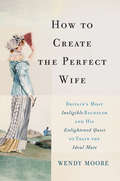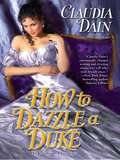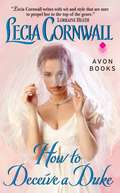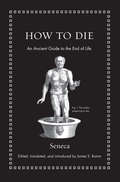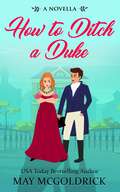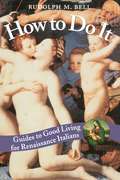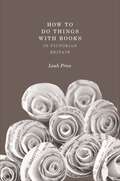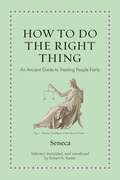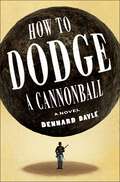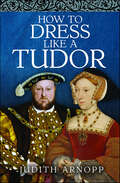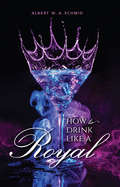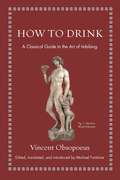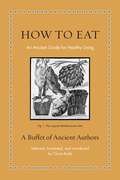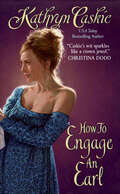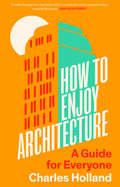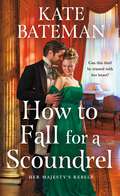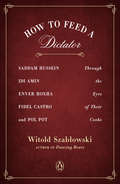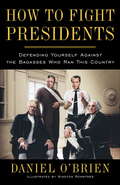- Table View
- List View
How to Create the Perfect Wife: Britain's Most Ineligible Bachelor and his Enlightened Quest to Train the Ideal Mate
by Wendy MooreThomas Day, an 18th-century British writer and radical, knew exactly the sort of woman he wanted to marry. Pure and virginal like an English country maid yet tough and hardy like a Spartan heroine, she would live with him in an isolated cottage, completely subservient to his whims. But after being rejected by a number of spirited young women, Day concluded that the perfect partner he envisioned simply did not exist in frivolous, fashion-obsessed Georgian society. Rather than conceding defeat and giving up his search for the woman of his dreams, however, Day set out to create her. So begins the extraordinary true story at the heart of How to Create the Perfect Wife, prize-winning historian Wendy Moore's captivating tale of one man's mission to groom his ideal mate. A few days after he turned twenty-one and inherited a large fortune, Day adopted two young orphans from the Foundling Hospital and, guided by the writings of Jean-Jacques Rousseau and the principles of the Enlightenment, attempted to teach them to be model wives. After six months he discarded one girl, calling her "invincibly stupid," and focused his efforts on his remaining charge. He subjected her to a number of cruel trials--including dropping hot wax on her arms and firing pistols at her skirts--to test her resolve but the young woman, perhaps unsurprisingly, eventually rebelled against her domestic slavery. Day had hoped eventually to marry her, but his peculiar experiment inevitably backfired--though not before he had taken his theories about marriage, education, and femininity to shocking extremes. Stranger than fiction, blending tragedy and farce, How to Create the Perfect Wife is an engrossing tale of the radicalism--and deep contradictions--at the heart of the Enlightenment.
How to Cross a Marquess (The Way to a Lord's Heart #3)
by Jane Ashford"A refreshingly different, sweetly romantic love story [readers] will long remember."—Booklist for Brave New EarlThe Marquess of Chatton and his neighbor Fenella Fairclough have known each other all their lives. They refused to marry each other years ago when their parents demanded it, and they won't concede now—even if circumstances have brought these former enemies much closer than they ever could have anticipated...The Way to a Lord's Heart:Brave New Earl (Book 1)A Lord Apart (Book 2)How to Cross a Marquess (Book 3)Praise for Jane Ashford:"Absolutely delightful...strong characters and interesting obstacles... a must read."—Night Owl Reviews for Brave New Earl"Wonderfully diverting...I give Last Gentleman Standing an enthusiastic recommendation."—Fresh Fiction for Last Gentleman Standing"Expertly crafted...another triumph of nuanced characterization and sparkling wit."—Booklist for Nothing Like a Duke"Vivid characters and lively plots...Conveyed with warmth and tenderness."—Publishers Weekly for Lord Sebastian's Secret
How to Dazzle a Duke
by Claudia DainPenelope Prestwick wants the Duke of Edenham for a husband, but figuring out how to dazzle him is no easy matter. Courtesan-turned- matchmaker Lady Dalby figures a bit of competition might do nicely...
How to Deceive A Duke
by Lecia CornwallWhen deception leads to desire . . .When her stubborn sister runs off the night before her arranged marriage, Meg Lyntonhardly hesitates before donning the wedding veil and walking down the aisle herself. It's the only way to save her family from sure destitution. By the time her wealthy groom discovers he has married the wrong sister, it will be too late to annul their vows. And too late for Meg to escape her wifely duty to a man reputed to be a devil in battle and the bedroom . . .A bride is the last thing Nicholas Hartley, Duke of Temberlay, wants. Then he sees Meg and realizes that his wedding night will be a great pleasure indeed. But aside from the agreeable business of begetting an heir, Temberlay will never change his wicked ways for a wedding vow?until he discovers Meg's deception, and decides to teach the scheming beauty how to be a proper duchess, kiss by devastating kiss
How to Deceive a Duke (Rebels with a Cause #2)
by Samara ParishFiona McTavish is an engineer, a chemist, a rebel—and no one&’s idea of a proper lady. She prefers breeches to ballrooms, but her new invention—matches—will surely turn as many heads. There&’s just a little matter of her being arrested for a crime she didn&’t commit. And the only person she can turn to for help is the man who broke her heart years ago.Edward Stirling, Duke of Wildeforde, will do anything to restore his family&’s name and put his father&’s scandalous death behind them. But when Fiona needs his help getting released from prison, he can&’t deny her—even though it means she must live with him as a condition of her freedom. With the desire between them rekindling as fast as the gossip about their arrangement is spreading among the ton, Edward will have to choose what matters most to him—his reputation or his heart.
How to Die: An Ancient Guide to the End of Life
by Seneca James S. RommTimeless wisdom on death and dying from the celebrated Stoic philosopher Seneca"It takes an entire lifetime to learn how to die," wrote the Roman Stoic philosopher Seneca (c. 4 BC–65 AD). He counseled readers to "study death always," and took his own advice, returning to the subject again and again in all his writings, yet he never treated it in a complete work. How to Die gathers in one volume, for the first time, Seneca's remarkable meditations on death and dying. Edited and translated by James S. Romm, How to Die reveals a provocative thinker and dazzling writer who speaks with a startling frankness about the need to accept death or even, under certain conditions, to seek it out. Seneca believed that life is only a journey toward death and that one must rehearse for death throughout life. Here, he tells us how to practice for death, how to die well, and how to understand the role of a good death in a good life. He stresses the universality of death, its importance as life's final rite of passage, and its ability to liberate us from pain, slavery, or political oppression. Featuring beautifully rendered new translations, How to Die also includes an enlightening introduction, notes, the original Latin texts, and an epilogue presenting Tacitus's description of Seneca's grim suicide.
How to Ditch a Duke: A REGENCY NOVELLA
by Jan Coffey May McGoldrickA PENNINGTON FAMILY NOVELLA Lady Taylor Fleming is an heiress with a suitor on her tail. Her step-by-step plan to ditch him is simple. But there is nothing simple about the Duke of Bamberg. Taylor tries to escape to sanctuary in the Highlands, but her plans become complicated when the duke arrives at her door and her loyal allies desert her. And even with the best laid plans, things can go awry…
How to Do It: Guides to Good Living for Renaissance Italians
by Rudolph M. BellHow to Do It shows us sixteenth-century Italy from an entirely new perspective: through manuals which were staples in the households of middlebrow Italians merely trying to lead better lives. Addressing challenges such as how to conceive a boy, the manuals offered suggestions such as tying a tourniquet around your husband's left testicle. Or should you want to goad female desires, throw 90 grubs in a liter of olive oil, let steep in the sun for a week and apply liberally on the male anatomy. Bell's journey through booklets long dismissed by scholars as being of little literary value gives us a refreshing and surprisingly fun social history. "Lively and curious reading, particularly in its cascade of anecdote, offered in a breezy, cozy, journalistic style." —Lauro Martines, Times Literary Supplement "[Bell's] fascinating book is a window on a lost world far nearer to our own than we might imagine. . . . How pleasant to read his delightful, informative and often hilarious book." —Kate Saunders, The Independent "An extraordinary work which blends the learned with the frankly bizarre." —The Economist "Professor Bell has a sly sense of humor and an enviably strong stomach. . . . He wants to know how people actually behaved, not how the Church or philosophers or earnest humanists thought they should behave. I loved this book." —Christopher Stace, Daily Telegraph
How to Do Things with Art: The Meaning of Art's Performativity
by Dorothea Von HantelmannArt has never been as culturally and economically prominent as it is today. How can artists themselves shape the social relevance and impact of their work? <P><P>In How to Do Things with Art, German art historian Dorothea von Hantelmann uses four case study artists--Daniel Buren, James Coleman, Jeff Koons and Tino Sehgal--to examine how an artwork acts upon and within social conventions, particularly through the performing of exhibitions. The book's title is a play on J.L. Austin's seminal text, How to Do Things with Words, which describes language's reality-producing properties and demonstrates that in saying there is always a doing--a linguistic counterpart to the dynamics envisioned by Von Hantelmann for art, in which showing is a kind of doing.
How to Do Things with Books in Victorian Britain
by Leah PriceHow to Do Things with Books in Victorian Britain asks how our culture came to frown on using books for any purpose other than reading. When did the coffee-table book become an object of scorn? Why did law courts forbid witnesses to kiss the Bible? What made Victorian cartoonists mock commuters who hid behind the newspaper, ladies who matched their books' binding to their dress, and servants who reduced newspapers to fish 'n' chips wrap? Shedding new light on novels by Thackeray, Dickens, the Brontës, Trollope, and Collins, as well as the urban sociology of Henry Mayhew, Leah Price also uncovers the lives and afterlives of anonymous religious tracts and household manuals. From knickknacks to wastepaper, books mattered to the Victorians in ways that cannot be explained by their printed content alone. And whether displayed, defaced, exchanged, or discarded, printed matter participated, and still participates, in a range of transactions that stretches far beyond reading. Supplementing close readings with a sensitive reconstruction of how Victorians thought and felt about books, Price offers a new model for integrating literary theory with cultural history. How to Do Things with Books in Victorian Britain reshapes our understanding of the interplay between words and objects in the nineteenth century and beyond.
How to Do the Right Thing: An Ancient Guide to Treating People Fairly (Ancient Wisdom for Modern Readers)
by SenecaHow ancient Stoicism can help teach us to treat others—and ourselves—more fairly and mercifully There are times when we&’ve all felt that we haven&’t been treated as we deserve—that we&’ve been misjudged, shortchanged, or given a raw deal. And, at one time or another, other people have probably felt that we&’ve treated them just as unfairly. How to Do the Right Thing draws on the principles of ancient Stoicism as articulated by the Roman statesman and philosopher Seneca to help readers better navigate one of the most important practical questions of daily life—how to do right by others.Starting from the virtue of magnanimity—the opposite of small-mindedness—How to Do the Right Thing draws together lessons from Seneca&’s writings that stress the importance of calm and clear thinking, of judging oneself fairly before judging others, and of cutting people slack, with a bias toward mercy—all delivered in crisp and lively new translations, and with the original Latin on facing pages.
How to Dodge a Cannonball: A Novel
by Dennard DayleHow to Dodge a Cannonball is a razor-sharp satire that dives into the heart of the Civil War, hilariously questioning the essence of the fight, not just for territory, but for the soul of America.How to Dodge a Cannonball is funnier than the Civil War should ever be. It follows Anders, a teenage idealist who enlists and reenlists to shape the American Future—as soon as he figures out what that is, who it includes, and why everyone wants him to die for it. Escaping his violently insane mother is a bonus.Anders finds honor as a proud Union flag twirler—until he’s captured. Then he tries life as a diehard Confederate—until fate asks him to die hard for the Confederacy at Gettysburg. Barely alive, Anders limps into a Black Union regiment in a stolen uniform. While visibly white, he claims to be an octoroon, and they claim to believe him. Only then does his life get truly strange.His new brothers are even stranger, including a science-fiction playwright, a Haitian double agent, and a former slave feuding with God. Despite his best efforts, Anders starts seeing the war through their eyes, sparking ill-timed questions about who gets to be American or exploit the theater of war. Dennard Dayle’s satire spares no one as doomed charges, draft riots, gleeful arms dealers, and native suppression campaigns test everyone’s definition of loyalty.Uproariously funny and revelatory, How to Dodge a Cannonball asks if America is worth fighting for. And then answers loudly. Read it while it’s still legal.
How to Dress Like a Tudor
by Judith ArnoppThe perfect how-to guide for dressing like your favorite Tudor. Have you ever hankered to dress like a Tudor lord or lady, or perhaps you prefer the status of goodwife, or costermonger, or even a bawd? For beginner historical reenactors, the path to authenticity can be bewildering and sometimes intimidating. Judith Arnopp uses her own experience, both as a historian and a medieval/Tudor lady, to make your own journey a little easier. The author traces the transition of fashion from the relatively subtle styles popular at the court of Henry VII, through the carefully constructed royal grandeur of Henry VIII, Edward VI, and Mary I to the pinnacle of majesty and splendid iconography of Elizabeth I. In contrast to the magnificence of court come the ordinary folk who, subject to sumptuary laws and regulations, wore garments of a simpler cut and cloth – a strata of society that formed the back bone of Tudor England. This brief history of sixteenth century fashion examines clothing for both rich and poor, adult and child, and offers tips and tricks on how to begin to sew your first historically inspired garment, this book is aimed at helping the beginner learn How to Dress like a Tudor.
How to Drink Like a Royal
by Albert W. Schmid"Royalty." A single word that invokes daydreams of champagne, lavish lifestyles, and extravagant parties. In How to Drink Like a Royal, Albert W. A. Schmid offers readers a taste of how the other half lives, with cocktail recipes inspired by some of the world's most famous dynasties. To ensure that you will delight even royal guests, Schmid also provides tips for proper etiquette, such as the requirement to stand if the Monarch is standing and to never, ever try to take a selfie. Discover cocktails like the Golden Doublet, created to celebrate the marriage of England's Princess Anne to Captain Mark Phillips, or the Savoy Royale created for Queen Elizabeth the Queen Mother on her visit to the Savoy Hotel, London. Other recipes give ode to royal families from works of literature, like the Beowulf Cocktail honoring King Hrothgar of the Danes. Even the royalty of the United States is featured through the Hawaiian Martini, an homage to the Hawaiian royal family who reigned from their palaces until 1893.With easy-to-follow glossaries for both royal and cocktail-making terms alongside 180 reciepes for a wide array of drinks that will quench any sort of thirst, How to Drink Like a Royal is an informative and light-hearted manual to help you cultivate your inner prince or princess.
How to Drink: A Classical Guide to the Art of Imbibing (Ancient Wisdom for Modern Readers)
by Vincent ObsopoeusA spirited new translation of a forgotten classic, shot through with timeless wisdom Is there an art to drinking alcohol? Can drinking ever be a virtue? The Renaissance humanist and neoclassical poet Vincent Obsopoeus (ca. 1498–1539) thought so. In the winelands of sixteenth-century Germany, he witnessed the birth of a poisonous new culture of bingeing, hazing, peer pressure, and competitive drinking. Alarmed, and inspired by the Roman poet Ovid's Art of Love, he wrote The Art of Drinking (De Arte Bibendi) (1536), a how-to manual for drinking with pleasure and discrimination. In How to Drink, Michael Fontaine offers the first proper English translation of Obsopoeus's text, rendering his poetry into spirited, contemporary prose and uncorking a forgotten classic that will appeal to drinkers of all kinds and (legal) ages.Arguing that moderation, not abstinence, is the key to lasting sobriety, and that drinking can be a virtue if it is done with rules and limits, Obsopoeus teaches us how to manage our drinking, how to win friends at social gatherings, and how to give a proper toast. But he also says that drinking to excess on occasion is okay—and he even tells us how to win drinking games, citing extensive personal experience.Complete with the original Latin on facing pages, this sparkling work is as intoxicating today as when it was first published.
How to Eat: An Ancient Guide for Healthy Living (Ancient Wisdom for Modern Readers)
by Claire BubbA delicious feast of ancient Greek and Roman writings on living well by eating well Today, we&’re stuffed with dietary recommendations from every direction. Social media, advertising, food packaging, diet books, doctors—all have advice on what, how much, and when to eat. This would have been no surprise to ancient Greeks and Romans. Their doctors were intensely interested in food, offered highly prescriptive dietary advice, and developed detailed systems to categorize foods and their health effects. How to Eat is a delectable anthology of Greco-Roman writings on how to eat, exercise, sleep, bathe, and manage your sex life for optimal health. It also gathers ancient opinions on specific foods of all sorts, from how to deploy onions to cure baldness and cabbage to get sober to whether lentils are healthy and why arugula increases your sex drive.With lively new translations by Claire Bubb, and the original Greek and Latin texts on facing pages, How to Eat features voices from medicine, philosophy, natural history, agriculture, and cooking, including Hippocrates, Pliny the Elder, Galen, Seneca, Plutarch, and Cato.While medicine and science have obviously changed enormously since the classical world, and some Greco-Roman beliefs about diet now appear hilariously off the mark, How to Eat reveals that much of their advice still resonates—and all of it is fascinating.
How to Engage an Earl (Royle Sisters #2)
by Kathryn CaskieThe last thing the Earl of MacLaren wants is a wife, so when he awakens to discover a fair-haired enchantress at the foot of his bed, he behaves as any man might by taking full advantage of the delicious situation. Then his family bursts in, and the chit brazenly announces that she is his betrothed. So he finds himself well on his way to being legshackled for life!Beautiful, reserved Anne Royle had never done anything so mad in her life. She entered the earl's bedchamber with no intention of seduction. Rather, she hoped to discover a document that could contain the truth about her heritage. But now her world is turned upside down, and while she trembles at the thought of her wedding night, she finds she longs for it in ways she never thought possible.
How to Enjoy Architecture: A Guide for Everyone
by Charles HollandCharles Holland challenges us to look beyond the day-to-day familiarity of buildings to rediscover the pleasure of experiencing architecture Architecture is bound up with our daily lives but, for most of us, it is experienced as a blur of habit. Our reactions towards the buildings that surround us are often culturally generated, and we experience them in ways that are immediate but often mundane. How to Enjoy Architecture: A Guide for Everyone encourages us to move beyond this and, instead, really look at buildings. Renowned architect Charles Holland talks about the buildings and architects that excite and inspire him, and the ideas and principles through which we can engage with architecture. By breaking buildings down into categories such as materials, structure, space, and use, Holland guides us through drastically different styles and building types—from the satisfying symmetry of a Queen Anne house to the thrill of a high-tech tower, or the social ideals that lie behind a housing estate. In doing so, he demonstrates how looking at, experiencing, and using architecture can bring joy in itself. "A book that will enrich any encounter with a building, it made me want to look harder and be more curious. We are led playfully through the fundamentals of architecture so that we might enjoy the details and the poetry of buildings all the more. A walk through the city feels more fun and also more profound after reading this book." Grayson Perry, artist "We so often encounter architecture when it goes wrong, or offends us with its looks. Holland, though, is the perfect, clear-headed tour guide to help us appreciate it with newly sharpened senses and fall in love again – even those buildings we think we hate." Tom Dyckhoff, academic and broadcaster "An enlightening and urbane exploration of architecture that resonates beyond conventional chronological histories" Catherine Slessor, architecture writer and critic
How to Enjoy Art: A Guide for Everyone
by Ben StreetAn entertaining and lively guide to rediscovering the pleasure in artHow to Enjoy Art: A Guide for Everyone provides the tools to understand and enjoy works of art. Debunking the pervasive idea that specialist knowledge is required to understand and appreciate art, instead How to Enjoy Art focuses on experience and pleasure, demonstrating how anyone can find value and enjoyment in art. Examples from around the world and throughout art history—from works by Fra Angelico and Berthe Morisot to Kazuo Shiraga and Kara Walker—are used to demonstrate how a handful of core strategies and skills can help enhance the experience of viewing art works. With these skills, anyone can encounter any work of art—regardless of media, artist or period—and find some resonance with their own experiences. How to Enjoy Art encourages us to rediscover the fundamental pleasure in viewing art.
How to Entice an Enchantress
by Karen HawkinsThe third sizzling novel in New York Times bestselling author Karen Hawkins's Duchess Diaries series, featuring three unruly sisters and their headstrong godmother with a penchant for matchmaking. Reclusive Viscount Kirk, horribly scarred by a tragic accident that stole the life of his beloved first wife, is a man defined by fury. For years he's eschewed society, growing abrupt and curmudgeonly. But now, when he'd given up on life, he's fallen madly in love with the refreshingly naive daughter of his neighbor, dainty and charming Dahlia Balfour. Desperate to win her attention, Kirk calls in a favor from the Duchess of Roxburghe and asks that she transform him into a fashionable suitor for Dahlia's hand. But what's easy to change on the outside, isn't as easy to change on the inside... Dahlia's always dreamed of a fairytale romance. Although Viscount Kirk is only seven years her senior, because of his cantankerous ways and lack of social graces she thinks of him as her "older neighbor," and is blissfully unaware that he sees her as anything other than an acquaintance. She is shocked to see him at the duchess's grand house party, trying to fit with the very societal rules he so frequently mocks. Surprised by his attention, irritated at his bald honesty, and intrigued that he finds her worth the effort, Dahlia regards Kirk as the opposite of Prince Charming. Without the pretty words and grand gestures she yearns for, can true love find its way into her unwilling heart?
How to Entice an Enchantress
by Karen HawkinsThe third sizzling novel in New York Times bestselling author Karen Hawkins's Duchess Diaries series, featuring three unruly sisters and their headstrong godmother with a penchant for matchmaking. The Duchess is doing it again! Matchmaking, that is. Bestselling author Karen Hawkins charms with a delightful retelling of Beauty and the Beast-- Scottish style. Scarred in the terrible accident that took his wife, gruff Lord Kirk has hidden himself from Society. When he meets his neighbor, Dahlia Balfour--a young beauty who shares his love for poetry and books--he realizes she is the one woman who could make him forget the past. But how can such a recluse attract the eye of an enchantress? Kirk appeals to his godmother, the Duchess of Roxburghe, to help him become the dashing, well-dressed hero of Dahlia's dreams. Arriving at a house party given by the Duchess, Dahlia is unprepared for the change in her neighbor. Suddenly, she is seeing him in a whole new light. When he captures her lips with an ardent kiss, she realizes he could be her romantic hero, but then a jealous rival twists an inadvertent comment she makes. Now Dahlia must persuade Kirk that she's not just a pretty girl feeling pity, but a passionate woman who sees past painful scars into the soul of the man she's come to love.
How to Fall for a Scoundrel (Her Majesty’s Rebels #2)
by Kate BatemanTwo unlikely allies team up to solve a case in this novel filled with Kate Bateman's signature sparkling voice, exciting adventures, and steamy chemistry.As a founding member of King & Co., London’s most successful private investigation firm, studious Eleanor Law delights in secretly proving that women can solve crimes just as well as men. When a charming con man pretends to be her fictional boss, "Charles King," Ellie knows he’s lying, but accepting the scoundrel’s offer of help might just be the key to cracking her new case and recovering a priceless manuscript.“Henri Bonheur”—or “Harry” as he asks to be called—claims his criminal past is behind him, but a man who steals and seduces with such consummate ease can never be trusted. As the investigation draws them deeper into danger and desire, Ellie’s infuriated to realize she’s developed feelings for her law-breaking accomplice. How can she love the scoundrel when she doesn’t even know his real name? And what will happen when Harry’s past finally catches up with him?
How to Feed a Dictator: Saddam Hussein, Idi Amin, Enver Hoxha, Fidel Castro, and Pol Pot Through the Eyes of Their Cooks
by Witold SzablowskiAnthony Bourdain meets Kapuściński in this chilling look from within the kitchen at the appetites of five of the twentieth century's most infamous dictators, by the acclaimed author of Dancing Bears.What was Pol Pot eating while two million Cambodians were dying of hunger? Did Idi Amin really eat human flesh? And why was Fidel Castro obsessed with one particular cow? Traveling across four continents, from the ruins of Iraq to the savannahs of Kenya, Witold Szabłowski tracked down the personal chefs of five dictators known for the oppression and massacre of their own citizens—Iraq&’s Saddam Hussein, Uganda&’s Idi Amin, Albania&’s Enver Hoxha, Cuba&’s Fidel Castro, and Cambodia&’s Pol Pot—and listened to their stories over sweet-and-sour soup, goat-meat pilaf, bottles of rum, and games of gin rummy. Dishy, deliciously readable, and dead serious, How to Feed a Dictator provides a knife&’s-edge view of life under tyranny.
How to Fight Presidents
by Winston Rowntree Daniel O'BrienMake no mistake: Our founding fathers were more bandanas-and-muscles than powdered-wigs-and-tea. As a prisoner of war, Andrew Jackson walked several miles barefoot across state lines while suffering from smallpox and a serious head wound received when he refused to polish the boots of the soldiers who had taken him captive. He was thirteen years old. A few decades later, he became the first popularly elected president and served the nation, pausing briefly only to beat a would-be assassin with a cane to within an inch of his life. Theodore Roosevelt had asthma, was blind in one eye, survived multiple gunshot wounds, had only one regret (that there were no wars to fight under his presidency), and was the first U.S. president to win the Medal of Honor, which he did after he died. Faced with the choice, George Washington actually preferred the sound of bullets whizzing by his head in battle over the sound of silence. And now these men--these hallowed leaders of the free world--want to kick your ass. Plenty of historians can tell you which president had the most effective economic strategies, and which president helped shape our current political parties, but can any of them tell you what to do if you encounter Chester A. Arthur in a bare-knuckled boxing fight? This book will teach you how to be better, stronger, faster, and more deadly than the most powerful (and craziest) men in history. You're welcome.
How to Fight, How to Kill: Child Soldiers in Liberia
by Human Rights WatchOver the last fourteen years, Liberians have known little but warfare. Conflict and civil war have devastated the country and taken an enormous toll on the lives of its citizens, especially children. Thousands of children have been victims of killings, rape and sexual assault, abduction, torture, forced labor and displacement at the hands of the warring factions. Children who fought with the warring parties are among the most affected by the war. Not only did they witness numerous human rights violations, they were additionally forced to commit abuses themselves.
